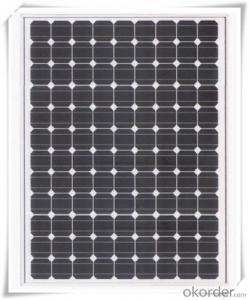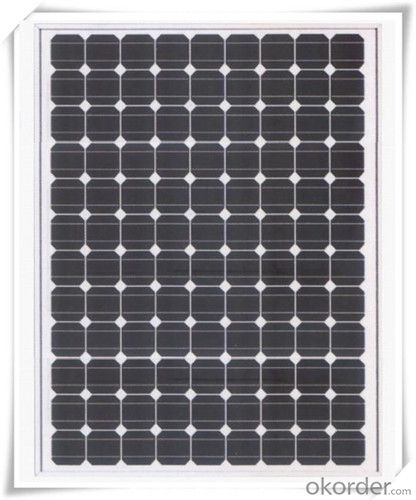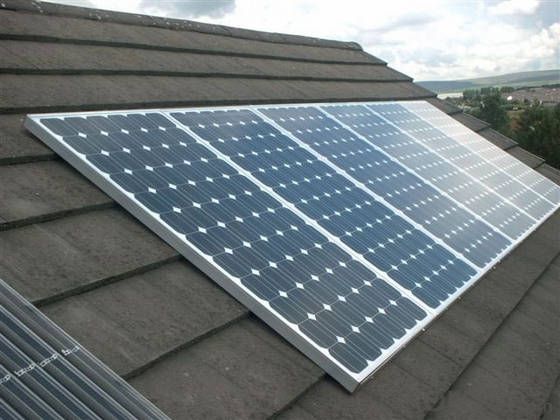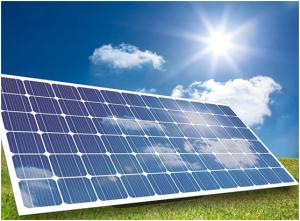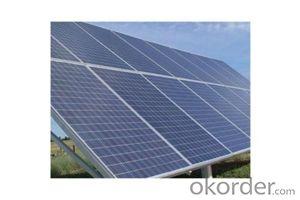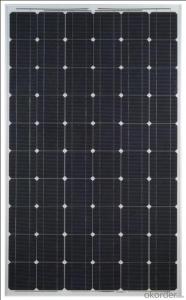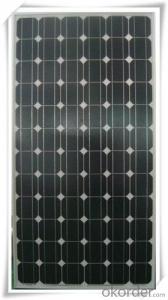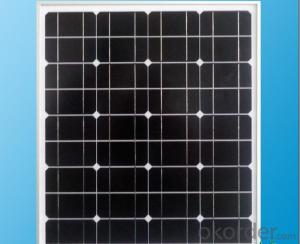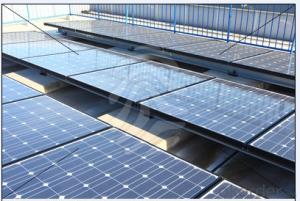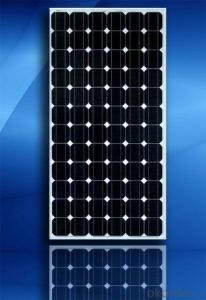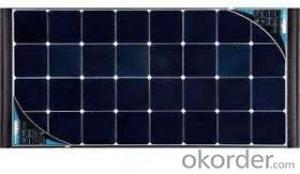Solar Panels Mi 160w Monocrystalline Solar Panel with 25 Years Warranty CNBM
- Loading Port:
- Qingdao
- Payment Terms:
- TT OR LC
- Min Order Qty:
- 10 set
- Supply Capability:
- 300000 set/month
OKorder Service Pledge
OKorder Financial Service
You Might Also Like
Monocrystalline Solar Panel with 160W
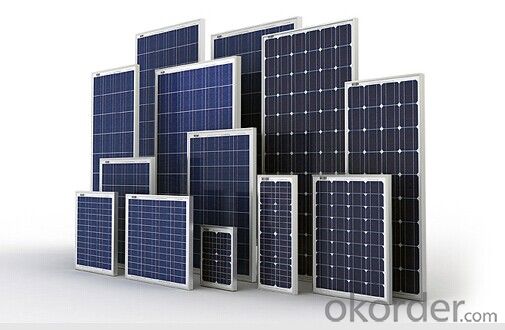
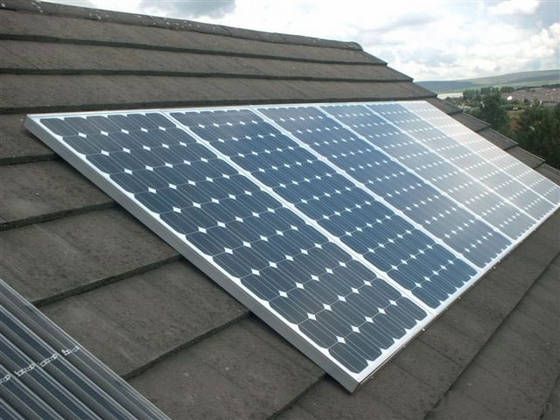
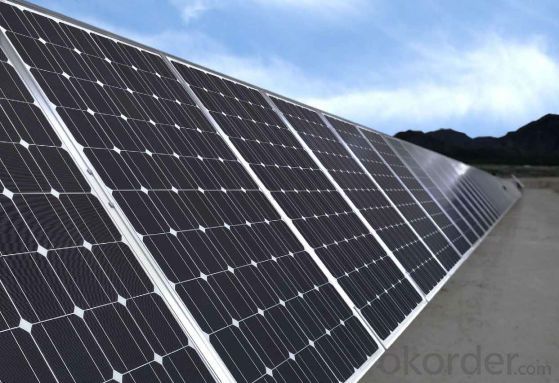
Monocrystalline Solar Modules
We offers a range of small, medium and large monocrystalline solar modules, designed for a range of requirements.
Specifications:
Tolerance | +/- 3% |
Cell | Monocrystalline silicon solar cells |
N0. of Cells | 72 (12 x 6) |
Dimension of Modules (mm) | 1581 x 809 x 40 |
Weight (kg) | 15.5 |
Limits:
Operating Temperature | -40~+85? |
Storage Temperature | -40~+85? |
Maximum System Voltage | 1000 VDC max. |
Hail Impact | Diameter of 28mm with impact speed of 86km/h |
Temperature and Coefficients:
NOCT | 48C+/-2? |
Voltage temperature coefficient (%/K) | -0.34 |
Current temperature coefficient (%/K) | 0.09 |
Power temperature coefficient (%/K) | -0.37 |
Characteristics:
Model: | SGM-160D | SGM-165D | SGM-170D |
Max-power voltage Vmp (V) | 34.5 | 35.4 | 35.8 |
Max-power current Imp (A) | 4.64 | 4.66 | 4.75 |
Open-circuit voltage Voc (V) | 41.75 | 43.6 | 43.32 |
Short-Circuit Current Isc (A) | 5.32 | 5.08 | 5.38 |
Max-power Pm(W) | 160 | 165 | 170 |
Model: | SGM-175D | SGM-180D | SGM-185D |
Max-power voltage Vmp (V) | 36.1 | 36.2 | 36.2 |
Max-power current Imp (A) | 4.85 | 4.97 | 5.11 |
Open-circuit voltage Voc (V) | 43.68 | 43.8 | 44.8 |
Short-Circuit Current Isc (A) | 5.49 | 5.48 | 5.51 |
Max-power Pm(W) | 175 | 180 | 185 |
STC: Irradiance 1000W/m2, Module temperature 25?, AM=1.5
Monocrystalline Solar Panels Specifications Range
Maximum Power (Pm) | Dimension | Weight | Operating Voltage (Vmp) | Operating Current (Imp) | Open Circuit Voltage (Voc) | Short Circuit Current (Isc) |
3W | 158x241x25mm | 0.5kg | 8.5V | 0.36A | 10.5V | 0.4A |
4W | 308x166x25mm | 0.77kg | 8.5V | 0.47A | 10.5V | 0.54A |
4W | 308.x166x25mm | 0.77kg | 16.8V | 0.24A | 21V | 0.27A |
5W | 296x215x25mm | 0.3kg | 16.8V | 0.48a | 21V | 0.54A |
10W | 286x406x25mm | 1.5kg | 16.8V | 0.59A | 21V | 0.66A |
12W | 286x406x25mm | 1.5kg | 16.8V | 0.71A | 21V | 0.8A |
14W | 286x541x25mm | 2kg | 16.8V | 0.83A | 21V | 0.96A |
16W | 286x541x25mm | 2kg | 17.2V | 0.93A | 21.5V | 0.99A |
18W | 296x541x25mm | 2.4kg | 18.8V | 1.07A | 21V | 1.2A |
20W | 296x641x25mm | 2.4kg | 17.2V | 1.15A | 21.5V | 1.24A |
24W | 541x451x25mm | 3.15kg | 16.8V | 1.14A | 21V | 1.56A |
26W | 541x451x25mm | 3.15kg | 17.2V | 1.51A | 21.5V | 1.63A |
30W | 296x966x25mm | 3.85kg | 16.8V | 1.78A | 21V | 2.03A |
36W | 541x641x35mm | 4.7kg | 16.8V | 2.14a | 21V | 2.4A |
40W | 541x641x35mm | 4.7kg | 17.2V | 2.33A | 21.5V | 2.5A |
55W | 1057x457x35mm | 6.6kg | 17.6V | 3.12A | 21.6V | 3.3A |
70W | 546x1196x35mm | 8.5kg | 16.8V | 4.15A | 21V | 4.7A |
75W | 546x1196x35mm | 8.5kg | 17.2V | 4.36A | 21.5V | 4.8A |
80W | 546x1196x35mm | 8.5kg | 17.6V | 4.55A | 21.6V | 4.9A |
110W | 1066x811x40mm | 11.8kg | 17.6V | 6.25A | 21.6V | 6.6A |
150W | 1066x811x40mm | 14kg | 34.4V | 4.36A | 43.2V | 4.7A |
- Q: I'm looking for a solar panel that has something you can plug thigs into, I don't know let's say grow lights. I want something that these lights can plug directly into and I can't find any online. If there is any I would like to know of the cheapest and best quality, I know that's an oxymoron but still. The lights are 600 watts so I need something somewhat strong. Thanks
- Homemade okorder
- Q: Hi All,I need some resources for a research project i'm doing on Solar Panels/Cells.So do you know of any good books or online materials that basically covers how solar cellwork from level 0 to calculating the energy output based on intensity of the light and the area of the panel. Book titles will be preferable but i'd like to build a strong base before tackling long and complicated formula(s)... so any suggestions? Your help will be appreciated :)THANKS IN ADVANCE!!
- How Solar Cells Work by Scott Aldous Inside This Article . Introduction to How Solar Cells Work 2. Photovoltaic Cells: Converting Photons to Electrons 3. How Silicon Makes a Solar Cell 4. Anatomy of a Solar Cell 5. Energy Loss in a Solar Cell 6. Solar-powering a House 7. Solving Solar-power Issues 8. Solar-power Pros and Cons 9. Lots More Information 0. See all Physical Science articles You've probably seen calculators that have solar cells -- calculators that never need batteries, and in some cases don't even have an off button. As long as you have enough light, they seem to work forever. You may have seen larger solar panels -- on emergency road signs or call boxes, on buoys, even in parking lots to power lights. Although these larger panels aren't as common as solar powered calculators, they're out there, and not that hard to spot if you know where to look. There are solar cell arrays on satellites, where they are used to power the electrical systems. You have probably also been hearing about the solar revolution for the last 20 years -- the idea that one day we will all use free electricity from the sun. This is a seductive promise: On a bright, sunny day, the sun shines approximately ,000 watts of energy per square meter of the planet's surface, and if we could collect all of that energy we could easily power our homes and offices for free.
- Q: i already have solar/gas water heating, but was wondering if getting solar panels for electricity installed was a good idea.
- Sure they work, photovoltaics. Light goes in, electricity goes out. Is it a good idea? Well. See, they're expensive. You probably need several kilowatts of capacity to run your house for one thing, and that's going to require several thousands of dollars worth of panels. And electricity doesn't cost that much. You can figure out how long it would take you to make the expense back. It would be a while. It would take even longer if you wanted to spring for a system that could take you completely off the grid, that would require banks of deep cycle batteries too. But most people are probably fine with a system that ties into the grid, and depending on who your utility is you may be able to sell surplus power back to them. Expense is the main reason I think you don't see a huge number of people adopting photovoltaics yet. Doesn't explain why solar heating isn't more popular though. That's really cheap and practical by comparison. But yeah you can find the photovoltaic panels for sale all over the place. Google it. Yeah the going rate for panels is around 2 bucks a watt.
- Q: what parts and tool do i need to build and connect a solar electric panel to my home
- Solar energy is very expensive. Or I should say, solar panels are expensive, because once you install them the power is free. A typical residential solar power system that supplies around a kilowatt of power at best conditions (noon, sunny day) will cost about $0,000. This includes the solar panel, the inverter (converts DC into AC), the cabling, but not installation (that would probably run you another $2000). One kilowatt is not that much electricity. It would run one microwave oven, or one hair dryer, or 0 light bulbs, and nothing else. Most houses use 3 times that at peak hours. So you would still likely get some power off the grid at peak time, and other times you can sell it back to make a little money. The good news is that solar panels are getting cheaper. They are around $5 per watt now, and are projected to drop to half that in the next decade. At some point, it will reach the sweet spot that makes solar an attractive alternative to grid power and more people will jump on board. There are some tax incentives too, but more would certainly help.
- Q: I made three 36 solar cell (3x6 .5V 3.5A) panel and had it hooked a up to an old car inverter. I was on line looking for a cheap grid tied inverter. I came across the Enphase micro inverter and was wondering if i could use one of those. Will it work?
- Have okorder . It might truly benefit anyone!
- Q: Can solar panels be used to power streetlights or outdoor lighting?
- Yes, solar panels can be used to power streetlights or outdoor lighting. Solar-powered streetlights or outdoor lighting systems consist of solar panels that capture sunlight and convert it into electricity, which is stored in batteries. This stored energy is then used to power the streetlights or outdoor lighting during the night or when there is insufficient sunlight. Solar-powered streetlights offer a sustainable and cost-effective solution for outdoor lighting, reducing energy consumption and carbon emissions.
- Q: Can solar panels be installed on a historic building?
- Yes, solar panels can be installed on a historic building. However, the installation process may require careful planning and consideration to ensure minimal visual impact and preservation of the building's historical integrity. Collaboration with preservation experts, architects, and local authorities is crucial to finding a suitable solution that balances renewable energy goals with the preservation of the building's historic value.
- Q: I have four power packs for solar lights. They have 3 AA .2volt batteries of 2450 mAh capacity installed in series for a total supply voltage of 4 volt maximum for the lights. I want to charge all four packs at once off a single 6 volt solar panel. With the four packs wired in parallel, what capacity output (wattage) panel do I need to charge the batteries in an 8 hour day?
- 325 mAh+ losses so maybe 3.2Ah to 3.5Ah.
- Q: Can solar panels be installed on a pergola or awning?
- Yes, solar panels can be installed on a pergola or awning. In fact, these structures can provide an ideal platform for solar panel installation, as they offer ample sunlight exposure and an elevated position that maximizes energy production. Installing solar panels on a pergola or awning can not only generate clean and renewable energy but also provide shade and protection from the elements.
- Q: How much per sq inch do they cost? Will i have to worry about them blowing off during hurricane season? If the sun isnt out for a week will my power go out? Will I have to check them every week and check which ones arent working and replace them? Is there anyway for them to be damaged by acid rain or any type of erosion like hail? When do I have to replace them? How do I dispose of old ones (like recycling)? What is smarter and more economical having few big panels or many small ones? I know I have alot of questions but I want a good detailed answer.
- The cost of solar is measured in dollars per watt. That means the cost of a cell that can make one watt continuously in full sunlight. A friend of mine is starting a new job to set up a new solar cell factory and he said the present cost is $3 per watt, but that they expect to get that down to $ per watt in a few years. They can be damaged by weather, just like any regular roof. My insurance agent asked if I had solar panels, so it is a factor in insurance cost. I never heard of recycling or disposing of old panels, maybe because they are so new and last so long that not many are ready to be disposed of yet.
Send your message to us
Solar Panels Mi 160w Monocrystalline Solar Panel with 25 Years Warranty CNBM
- Loading Port:
- Qingdao
- Payment Terms:
- TT OR LC
- Min Order Qty:
- 10 set
- Supply Capability:
- 300000 set/month
OKorder Service Pledge
OKorder Financial Service
Similar products
Hot products
Hot Searches
Related keywords
